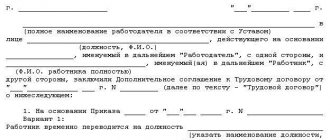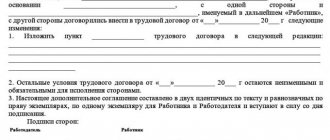Is it possible to transfer to another position during IP?
The translation is carried out according to established rules.
The question often arises about whether it is possible to transfer to another position during the probationary period.
This can happen for a variety of reasons, for example, a more “profitable” position has appeared or one that corresponds to the employee’s main specialty, or the employee has realized that he cannot cope with the obligations of the position in which he is currently located.
This question can be answered as follows: it is possible to transfer to another position during the probationary period, but there are several nuances that must be observed.
- If the transfer is carried out within the organization, then establishing a full probationary period for the new position is unacceptable, since it is a direct violation of the law;
- But at the same time, the law does not require the employer to terminate the employee’s probationary period early when transferring him to another position.
Thus, it can be concluded that if the transition from one position to another is carried out during the probationary period, then the probationary period cannot be extended. At the same time, it can be terminated early at the initiative of the employer.
Such a transfer should be documented in the same way as a transfer outside the employee’s probationary period, that is, create an appropriate order, conclude a new employment contract, having previously terminated the old one, or supplement the main contract with a special agreement. In addition, it is necessary to make a corresponding entry in the work book.
From this video you will learn about dismissal by transfer.
Form for receiving a question, write yours
Features of various types of transfers
In existing labor relations, there are several types of transfers that can be carried out by an employer in relation to an employee within the same organization. The most complex types of translations that have a large number of pitfalls are:
- transfer of a part-time worker to the main position. This type of transfer is the most optimal only in cases where we are talking about an internal part-time worker due to the fact that in other cases the part-time worker will have to completely terminate the existing employment relationship at the main place of work, which may be fraught with additional time costs. If the transfer is carried out for an internal part-time worker, then the employee’s opportunity to begin performing duties in a new position increases significantly. The registration of such a transfer is carried out by making changes to the work book, as well as recording the completed transfer in an additional agreement to the employment contract;
- transfer without changing position (relocation). This type of transfer is carried out within the same organization, but with a change in the unit in which the employee works. Such a transfer can be temporary or permanent and dictated by production needs. When making such a transfer, the employer has the right not to ask the employee’s opinion on the transfer, having issued an order on the need for such a personnel reshuffle;
- A temporary transfer is a complete or partial change in an employee’s job function if such a change is dictated by production needs. Most often, such a transfer is carried out to replace an employee who is temporarily absent from work for a valid reason. The period of such transfer cannot exceed one year, and the occupation of the position to which the employee was transferred ceases at the moment the replaced person returns to work.
https://youtu.be/2tCQcPKbOWA
On whose initiative can the translation be made?
- If the initiator of the transfer is an employee, then a written statement about this is required from him. In order to have some guarantees, he may require a letter of invitation from the potential employer. This will give him the opportunity to conclude a new employment contract within a month, and he can also count on paying for his move to an organization located in another area. The employee’s desire must be reported to the management of the company where he wants to get a job. the work book will indicate that the transfer was made at the request of the employee. The new company does not have the right to refuse to conclude an employment contract with the transferred person. If this condition is violated, a fine will be imposed. Also, the transferred person cannot be placed on a probationary period. In this translation option, the current management may require the personnel to work for the period established by law, which cannot exceed two weeks. This is necessary so that management has the opportunity to find an appropriate specialist for the vacant position.
- A contract between two organizations may be the reason for the transfer. This happens when one enterprise is going to close, and in order to provide its employees with new jobs, it negotiates with other companies to provide vacancies. Such a transfer requires agreement between three parties. First of all, the head of the company where the person who is to be transferred works sends a letter of request to another company with a request to hire a new specialist. In one letter you can request a transfer for one or several people. After receiving and reading this letter, the management of the new company writes its resolution. If consent is received, then the previous management draws up a dismissal order.
You can get detailed information about moving to another job from this video:
Labor consultant
For example, if this is a branch, it may be located in another area of the city, or maybe in another region; location of the organization's structural unit. In some cases, due to an emergency situation, such as a work injury, fire at work, etc.
etc. the transfer will become legal without the consent of the worker in order to eliminate the incident for a period not exceeding one month. A transfer can also be carried out without consent if it is necessary to immediately replace an employee who is absent from the workplace, or if it is necessary to prevent damage or liquidation of property.
It is illegal to increase the probationary period, and such a move is considered a violation of the employee’s rights; explanations on this issue are spelled out in the ninth article
Procedure for completing a translation
The initiator of a transfer to another company can be both the employee and his employer. But in both situations it is necessary to terminate one employment contract and enter into a new one in return. In this case, no additional agreement is allowed. This is explained by the fact that this procedure involves not two persons, but three: the employee, the current and potential employers.
So, in order to make a transfer, the written consent of the following participants is required:
- employee;
- the employer for whom he currently works;
- an employer who wants to employ this personnel.
Translation stages:
- The first step before translation is correspondence. It passes between the organization in which the person works and the company that wants to host this employee. The second enterprise asks the first to transfer the person to them. At this stage, the most important document is the invitation letter, which contains a request for transfer. This document shows that the inviting party agrees to host the employee.
- At the second stage, it is necessary to obtain the consent of the frame itself. The main factor here is who initiated the transfer - the employer or the employee. If the employer, then it is imperative that the employee writes a written agreement. Consent can be expressed in the following forms:
- The inscription on the employer’s offer of transfer: “I agree to the transfer”;
Separately written agreement.
Also, as consent, a resignation letter may be considered, the reason for which is a transfer to another organization. An invitation letter from the new company can be attached to this application. Consent is also considered a general agreement between the employer and employee on the transfer, which is confirmed by the termination of the employment contract.
The employee must receive monetary compensation in the form of salary for the time he worked, as well as for unused vacations. They pay him on the day of actual dismissal. If for some reason a person was unable to receive the money within the period established by law, then he can come for payment no later than the next day after declaring his desire to receive the necessary compensation.
If dismissal by transfer occurs at the time of illness, then the management of the organization must pay the person the entire amount due to him as sick leave. If an enterprise has no money, this is not a reason for non-payment of financial compensation.
How to transfer to work in another organization
An employee can move to another company or enterprise based on mutual agreement on the part of the current and future employers. According to the Labor Code of the Russian Federation, the initiator of a transfer can be either the employer or the employee himself. The procedure for transferring an employee begins with the registration of the dismissal procedure at the current place of work, since in the organization where he is transferring, an employment agreement will be concluded with him. In this case, an important place is given to written agreement between the management of the organization where the employee currently works and the head of the organization where he intends to transfer.
At this stage the following happens.
- On behalf of the head of the organization where the employee will work, a letter of request is drawn up using a special form. It must indicate the employee’s new position and the expected date when the employee will begin work in the new place.
- A letter of request is sent to the organization where the citizen currently works.
- After receiving this letter of request, the head of the organization of the employee's current place of work must agree on the possibility of transfer with the employee.
- In the case when an employee agrees to a transfer, he will have to write a statement in which he must indicate that he is resigning due to the transfer. A letter of request is attached to the employee's application.
- In turn, the head of the organization of the employee’s current place of work sends a confirmation letter to the organization of the employee’s transfer.
- Next, the employee is dismissed, after which he gets a job in a new organization.
Actions related to dismissal when transferring an employee to another organization
- An order is issued on the basis of which the employment contract is terminated in connection with the transfer (Form No. T-8).
- The employee’s personal card must be closed (Form No. T-2).
- The following entry is made in the work book: “Dismissed by transfer to (name of organization) with the consent of the employee.”
Actions with documents in a new organization:
- An employment contract is signed with the citizen.
- An order is issued on the basis of which a new employee is accepted into the organization (Form No. T-1).
- A new employee is given a personal card (form No. T-2).
- An entry with the following content is made in the work book: Accepted (name of structural unit) to the position (name of position) in the order of transfer from (name of organization).
How does the transfer process occur when the initiative comes from the employee himself?
In a situation where the employee himself is the initiator of the transfer, the stages of the transfer will be as follows:
- The employee writes a written statement in connection with the transfer.
- The head of the organization in which the employee currently works informs in writing about his employee’s intention to transfer to the head of the organization where the employee expressed a desire to transfer, and receives his approval.
- The entire hiring and dismissal procedure is carried out in accordance with the general rules. In the work book of an employee who is resigning, it is necessary to make an entry about his dismissal, indicating that the employee was transferred at his own request.
Is it possible to assign a probationary period when transferring to another position?
Career movement The transfer of an employee to another position is considered legal only with his consent. The order is issued after the employee writes an application or a memorandum that justifies the transfer. It is drawn up by the HR department inspector, signed by the manager, and the employee is notified upon signature. Reasons for the transfer Regardless of the reason for the transfer, changes must be made to the employment contract.
Amendments to it are formalized by an additional agreement, which is signed by the parties. The procedure for processing documents is regulated by the resolution of the State Statistics Committee of the Russian Federation, adopted in January 2004, as well as by the provisions of Articles 57, 72 and 72.1 of the Labor Code of the Russian Federation.
The transfer order is issued on a unified form No. T-5 or No. T-5a, which is approved by the above resolution.
Dismissal followed by hiring as a way to assign an additional probationary period
If checking the suitability of a new position is a fundamentally important point for the boss, then the law provides for the signing of a new contract, but the old one must be terminated by mutual consent. Usually, the breakup and conclusion in such cases occur simultaneously, so that the subordinate does not have any fears that the dismissal is final.
In this case, the employer is obliged:
- Make an entry in the work book.
- Pay compensation for unused vacation or time off.
- If the employee refuses compensation, provide him with vacation or time off.
The work experience required to receive annual paid leave to a new position in the event of prior dismissal is not transferred. The employee does not have the right to severance pay with this method of dismissal.
Legally savvy managers often disguise the probationary period as a temporary transfer to a new location. According to labor standards, the maximum possible period for such a transfer should not exceed 3 months (6 months for managers and accountants). If an employee does not begin to cope with new responsibilities within the allotted time, then management must return him to his previous position without loss of wages. Reappointment in this case must be permanent. Dismissal due to inadequacy of the new position is impossible, since failure to pass the test is not a legal reason for dismissal.
It should be remembered that transfer to a new place is possible only with the consent of the employee. Refusal cannot be a reason for dismissal. If you do not want to take a new position, you must notify your superiors in writing in the form of a notification or endorsement of a refusal to transfer the transfer order.
Temporary transfer
Also, the employer can “cover” the probationary period with a temporary transfer to a new position. Such a transfer cannot last more than three months and is possible only with the consent of the employee. At the end of the period, if management decides that the specialist can handle the new responsibilities, he must be transferred to permanent employment. Otherwise, it must be returned to its original position. Dismissal in this situation is also illegal.
Watch a video that will tell you about temporary transfer to another job
Enter the site
You can add a topic to your favorites list and subscribe to email notifications.
Now just thoughts. For example, an employee is promoted, if he has no previous experience of such work, then the probationary period will allow him to check the business, professional and other qualities of the employee. It’s scary when you realize that every person has their own safe, and you can open it...
Minsk is my place of residence! “As a general rule, a preliminary test is established only at the time of initial hiring.
When transferring an employee (including from the same employer), no preliminary test is established.” I look at the analytics and it’s the same thing, although it’s quite contradictory.
Current issues regarding the transfer of an employee to another organization
No. In accordance with the established rules under Art. 64 of the current Labor Code of the Russian Federation, the ban can be valid only for one month from the moment the citizen quit his previous job.
If, despite this, an employment contract is not concluded, this means that the head of the organization where the transfer is taking place is violating labor laws. Penalties for the above offenses include:
- For managers of an organization who ignored labor legislation, a fine of 1000-5000 rubles. (a repeated violation of this type will result in disqualification for a period of 1-3 years).
- The organization itself will be fined from 30,000 to 50,000 rubles.
If a new employer refuses to employ an employee, this cannot but affect the previous employer. An employee can exercise his legal right to appeal the refusal of employment in court, in addition, he can demand that he be reinstated at the place of work from which he was fired. At the same time, at the previous place of work, the employee who was reinstated will be fully paid for the time when he was forced not to work, in the amount of average earnings.
During legal proceedings, a decision may be made in which the organization will have to compensate for moral damages to an employee who was fired from work illegally. The nature of the moral damage caused to the employee and the degree of guilt of the organization are determined in court.
What should be done when the dismissal of an employee from his previous job is considered illegal?
In this situation, when the dismissal is considered illegal, an appropriate order is issued, on the basis of which the employee is reinstated in his position. This is reflected in the entry that must be made in the work book. For example: “Record No.___ is invalid, reinstated in previous position.” In column No. 4 of the work book opposite this entry, the details of the order according to which the employee was reinstated must be entered.
When transferring to work on a permanent basis in another organization, can the new employer legally establish a probationary period?
No way. In this situation, a probationary period when transferring an employee is not provided for under the Labor Code of the Russian Federation and, therefore, cannot be established.
If an employee, despite labor legislation, is given a probationary period, this will entail penalties:
- The leaders of the organization will have to pay 1000-5000 rubles. (if such a violation occurs again, the organization’s officials will be disqualified).
- The fine for the organization will be 30,000-50,000 rubles.
When an employee is transferred to a new organization, is a reduction in salary allowed compared to what he received before?
An employee's salary may decrease. Since the transfer of an employee to another organization is carried out only with his consent, it means that he does not object to a decrease in the level of wages compared to his previous place of work. Labor legislation does not guarantee compliance with a constant salary level when transferring from one organization to another.
How to transfer to work in another organization
An employee can move to another company or enterprise based on mutual agreement on the part of the current and future employers. According to the Labor Code of the Russian Federation, the initiator of a transfer can be either the employer or the employee himself. The procedure for transferring an employee begins with the registration of the dismissal procedure at the current place of work, since in the organization where he is transferring, an employment agreement will be concluded with him. In this case, an important place is given to written agreement between the management of the organization where the employee currently works and the head of the organization where he intends to transfer.
At this stage the following happens.
- On behalf of the head of the organization where the employee will work, a letter of request is drawn up using a special form. It must indicate the employee’s new position and the expected date when the employee will begin work in the new place.
- A letter of request is sent to the organization where the citizen currently works.
- After receiving this letter of request, the head of the organization of the employee's current place of work must agree on the possibility of transfer with the employee.
- In the case when an employee agrees to a transfer, he will have to write a statement in which he must indicate that he is resigning due to the transfer. A letter of request is attached to the employee's application.
- In turn, the head of the organization of the employee’s current place of work sends a confirmation letter to the organization of the employee’s transfer.
- Next, the employee is dismissed, after which he gets a job in a new organization.
Actions related to dismissal when transferring an employee to another organization
- An order is issued on the basis of which the employment contract is terminated in connection with the transfer (Form No. T-8).
- The employee’s personal card must be closed (Form No. T-2).
- The following entry is made in the work book: “Dismissed by transfer to (name of organization) with the consent of the employee.”
Actions with documents in a new organization:
- An employment contract is signed with the citizen.
- An order is issued on the basis of which a new employee is accepted into the organization (Form No. T-1).
- A new employee is given a personal card (form No. T-2).
- An entry with the following content is made in the work book: Accepted (name of structural unit) to the position (name of position) in the order of transfer from (name of organization).
How does the transfer process occur when the initiative comes from the employee himself?
In a situation where the employee himself is the initiator of the transfer, the stages of the transfer will be as follows:
- The employee writes a written statement in connection with the transfer.
- The head of the organization in which the employee currently works informs in writing about his employee’s intention to transfer to the head of the organization where the employee expressed a desire to transfer, and receives his approval.
- The entire hiring and dismissal procedure is carried out in accordance with the general rules. In the work book of an employee who is resigning, it is necessary to make an entry about his dismissal, indicating that the employee was transferred at his own request.
Procedure for transferring an employee
Many people mistakenly believe that it will be much easier for an employee who plans to transfer to quit and get hired again. To make sure how true this statement is, you can imagine the following situation. Suppose that an employee of a company, after a preliminary conversation with a potential future employer, hastened to quit his job. But then the unexpected happened: some circumstances changed, and therefore the new company changed their minds and refused to hire him. Instead of a new promising position in a new place, a person may be left completely without work.
This situation can be avoided if you follow the Labor Code, which gives citizens a real opportunity to protect themselves. To do this, you will need to know that a future employer must invite you to another job only in writing.
The employee must begin work duties within a month from the moment he left another job. This gives the employee the right to enter into an employment agreement immediately after dismissal, which may not happen with a simple dismissal.
If an employee is transferred from another organization, new managers do not have the right to establish probationary periods. If a citizen simply quits and comes to get a job, then he may be assigned a probationary period.
Documenting
As mentioned earlier, the Labor Code of the Russian Federation stipulates the possibility of establishing tests for workers. But, like other conditions, they must be enshrined in law.
The main thing that the employer should pay attention to is that he does not have the right to worsen those aspects that have already been enshrined in the legislative norms of the Russian Federation.
Therefore, when establishing a probationary period, the employer should adhere to the following deadlines:
- Employees hired under fixed-term contracts for a period not exceeding a total of six months may undergo testing for no more than two weeks at a time.
- Other new employees, regardless of whether they have fixed-term or open-ended agreements, can be tested for three months, but no more.
- Certain categories of management positions, such as directors and their deputies, chief accountants and their deputies, have increased probationary periods, which are equal to six months.
Based on the maximum deadlines set out in Article 70 of the Labor Code of the Russian Federation, the employer can set its own standards. It is necessary to prescribe individual norms in the collective agreement of the organization, having previously discussed this item with representatives of the workforce. It can prescribe different durations for certain categories of employees or prescribe a general condition for all accepted permanent employees.
The employment contract must indicate individual information about the established tests and their duration. If the information is specified in the collective agreement, but not in the agreement, then the employee is considered to be exempt from this condition.
Legal framework for establishing a probationary period
The whole point of screening a hired employee is to look at his capabilities. According to the Labor Code, such a measure can only be applied immediately after the conclusion of an employment contract. Moreover, it must clearly state the conditions and timing of such an inspection. The legislator’s position is that if an employee is transferred to a new position or to another department, the manager is already aware of his working qualities and level of training. Therefore, ordering a repeat inspection is considered a violation of the employee’s rights. A probationary period for transfer to another position is not assigned.
A short list of articles of the Labor Code regulating the procedure for establishing a probationary period:
- Article 72 – reveals the procedure for changing the provisions of the employment contract in the event of a transfer to a new position;
- Article 72.1 – explains the essence of job transfer;
- Article 72.2 – details the conditions for transfer on a non-permanent basis;
- Article 73 – specifies aspects of transfer to another position for health reasons;
- Article 74 – considers the nuances of translation due to staffing or technological changes of the enterprise;
- Article 75 – describes the circumstances of the transition during reorganization or the emergence of a new owner of the company.
It is their provisions that should be relied upon when controversial situations arise related to transfer to a new position.
It should be noted that it is prohibited to establish a probationary check for certain categories of citizens.
These include:
- applicants who passed the competition;
- persons who have won the competition for an elective position;
- persons who received an invitation to work;
- employees working under a temporary agreement, the duration of which is up to 2 months;
- minors;
- Pregnant women and mothers of children under 1.5 years of age;
- persons who have received secondary or higher education at a state accredited institution and are getting a job for the first time.
For other categories of citizens, management has the right to verify compliance with the requirements.
Theoretically, re-testing is possible only when a new employment contract is signed. However, enterprise management almost never uses this practice. The reason for this is the complexity of the documentation (the old contract must be terminated and the corresponding note must be made in the work book). If such facts are revealed, the Labor Inspectorate may have a number of questions for such a company, which is fraught with the imposition of sanctions. By mutual agreement of the parties, changes may be made to the employment contract, implying an extension of the probationary period. But this is unprofitable for the subordinate, so in practice the original form of the employment contract is not adjusted.
If you disagree with the illegal extension of the period, the employee must submit a corresponding application addressed to the director in two copies, one of which must remain in hand. If the situation cannot be resolved peacefully, then on the basis of the statement made, you can send a complaint to the labor inspectorate, prosecutor's office or judicial authorities.
If during the inspection a vacancy appears in the organization that is more profitable for the intern, then management can transfer him to a new place. However, the total verification time is maintained.
The manager has the right to transfer the employee to a new position before the end of the internship. A new check will not be scheduled, but the old one will have to be completed. Extension of deadlines during the transition is also not possible.
In accordance with regulatory labor legislation, the manager has the right to reduce the duration of the probationary period. This is possible if the trainee has proven himself to be a competent specialist who fully satisfies the requirements of the institution. In this case, the employer must draw up an additional agreement confirming the reduction in test time.
Failure to complete the probationary period is not grounds for dismissal. This is illegal, even if the subordinate has signed a corresponding agreement. In this case, you can be reinstated in court.
A legitimate reason for extending the probationary period is considered to be only the long-term absence of the hired employee from the workplace due to sick leave or vacation.
Why can't you set a probationary period?
The purpose of the probationary period is to check the employee’s suitability for the position held. But in the event of a transfer, the organization’s management already had the opportunity to evaluate the business qualities and skills of the individual. But, if we are talking about an increase or change in the nature of the activity, then the question of establishing a probationary period may well arise.
Read more: Free legal consultation online 24 hours a day
Dismissal of an employee due to failure to complete the probationary period is unlawful. Even if he signed the corresponding additional agreement. He must be reinstated. If the employer does not do this, the employee can go to court.
Moreover, if an employee was asked to move to another position during the probationary period, this does not mean automatic termination of its validity, since its cancellation is possible at the request of the employer. Extending the probationary period in such a situation is also prohibited by current legislation, because this is a restriction of labor rights. It is possible only if the employee was not present at the workplace and did not physically perform his duties for a certain number of days, for example, due to sick leave.
If the federal labor inspectorate detects violations of labor legislation of this nature, the employer faces an administrative fine or administrative suspension of activities.
A lawyer talks about the features of transferring to another job










